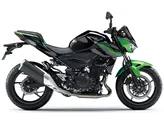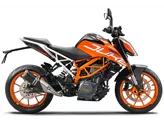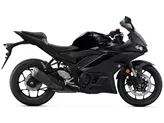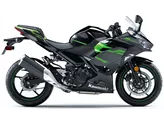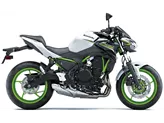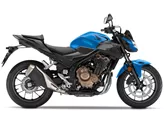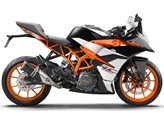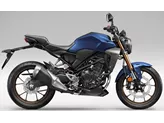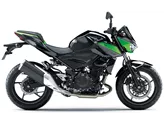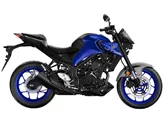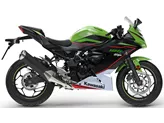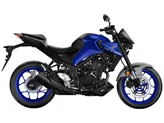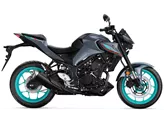Kawasaki Z 400 2019 vs. Kawasaki Ninja 400 2018

Kawasaki Z 400 2019

Kawasaki Ninja 400 2018
Visão geral - Kawasaki Z 400 2019 vs Kawasaki Ninja 400 2018
In comparing the Kawasaki Z 400 2019 and the Kawasaki Ninja 400 2018, both models share many similarities in terms of their technical specifications. They both have an inline engine with a bore of 70 mm and a stroke of 51.8 mm. The power output of both models is 45 HP, with a torque of 38 Nm. They also have the same compression ratio of 11.5 and use fuel injection as their fuel system. The displacement of both bikes is 399 cc, and they have liquid cooling for the engine.
In terms of suspension, both models feature a telescopic fork for the front suspension with a diameter of 41 mm. The rear suspension consists of a swingarm with a monoshock and pre-load adjustment. The chassis of both bikes is made of steel and has a tubular frame design. The rake angle of the Z 400 is 65.5 degrees, while the Ninja 400 has a rake angle of 63 degrees. The trail measurement for the Z 400 is 92 mm, while the Ninja 400 has a trail of 93 mm.

Kawasaki Z 400 2019
Both bikes have a single disc front brake with a diameter of 310 mm and a dual-piston caliper. They also come equipped with ABS as an advanced rider assistance system. The dimensions and weights of both models are also similar, with a front tire width of 110 mm and a diameter of 17 inches, and a rear tire width of 150 mm and a diameter of 17 inches. The wheelbase for both bikes is 1370 mm, and the seat height is 785 mm. The curb weight, including ABS, is 167 kg for the Z 400 and 168 kg for the Ninja 400. Both models have a fuel tank capacity of 14 liters.
Now let's discuss the strengths and weaknesses of each model. The Kawasaki Z 400 2019 has several strengths. It offers excellent and very controllable power, making it suitable for both experienced and beginner riders. The bike has a reduced weight, which contributes to its agility and maneuverability. The seating position is comfortable, and the bike produces a great sound. These features make it well-suited for novice riders.
On the other hand, the Kawasaki Ninja 400 2018 also has its own set of strengths. The chassis is suitable for sporty riding, and the bike's reduced weight allows for effortless handling. The engine provides smooth and responsive performance, and the relaxed seating position instills confidence in the rider. Additionally, the bike is equipped with LED headlights, which enhance visibility.

Kawasaki Ninja 400 2018
However, both models have some weaknesses. The clutch and brake levers on both bikes are not adjustable, which may be a drawback for riders who prefer personalized controls. The Z 400 also has limited chassis adjustment options. The Ninja 400, on the other hand, has a high wind noise with the stock windshield for riders over 180 cm tall.
In conclusion, both the Kawasaki Z 400 2019 and the Kawasaki Ninja 400 2018 are similar in terms of their technical specifications. They offer excellent power and performance, with comfortable seating positions. However, they do have some weaknesses, such as non-adjustable levers and limited chassis adjustments. Ultimately, the choice between the two models will depend on the rider's preferences and intended use of the bike.
Especificações técnicas Kawasaki Z 400 2019 em comparação com Kawasaki Ninja 400 2018
Prós e contras em comparação
Prós e contras em comparação
Kawasaki Z 400 2019

A Kawasaki Z400 é definitivamente uma grande evolução da sua antecessora, a Z300. Mais potência, menos peso - em suma, simplesmente uma moto ainda melhor. Acima de tudo, a entrega de potência linear e o excelente manuseamento fazem da Z400 uma moto de entrada de gama ideal. A facilidade de operação da embraiagem e a boa configuração do quadro também estão nesta linha, razão pela qual a Z400 pode ser recomendada sem hesitação a pilotos principiantes.
Kawasaki Ninja 400 2018

Em resumo, a Ninja 400 pode ser descrita como a entrada perfeita no mundo das superdesportivas. Não é possível obter mais potência com a A2, o aspeto sugere muito mais potência, o veículo é divertido de conduzir, é indulgente em todos os aspectos e ainda permite um estilo de condução verdadeiramente desportivo. Aqueles que tinham preocupações legítimas sobre a falta de potência nas várias máquinas de 250 cúbicos agora não têm mais desculpas. Ninja 400, é bom ter-te connosco!
Comparação de preços Preço médio de mercado Kawasaki Z 400 vs Kawasaki Ninja 400
There are a few key differences between a Kawasaki Z 400 2019 and a Kawasaki Ninja 400 2018. In terms of price, the actual average price of a Kawasaki Ninja 400 2018 is about 19% higher. A Kawasaki Z 400 2019 experiences a loss of 330 EUR in one year of ownership. This is offset by a loss of 160 EUR for a Kawasaki Ninja 400 2018. Compared to Kawasaki Ninja 400 2018 there are less Kawasaki Z 400 2019 bikes available on the 1000PS.de Marketplace, specifically 6 compared to 10. It takes less time to sell a Kawasaki Z 400 with 99 days compared to 105 days for a Kawasaki Ninja 400. Since model year 2019 1000PS.de editors have written 8 reviews for the Kawasaki Z 400 and 9 reviews for the Kawasaki Ninja 400 since model year 2018. The first review for the Kawasaki Z 400 was published on 02/10/2018 and now has more than 23 200 views. This compares to more than 44 300 views for the first review on Kawasaki Ninja 400 published on 22/11/2017.


